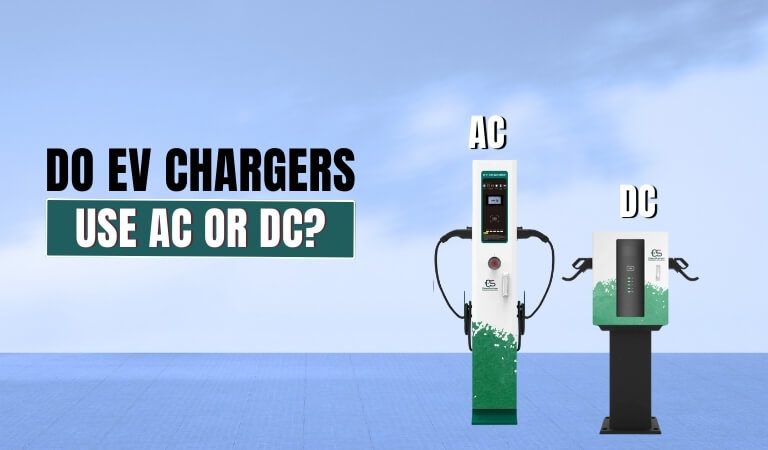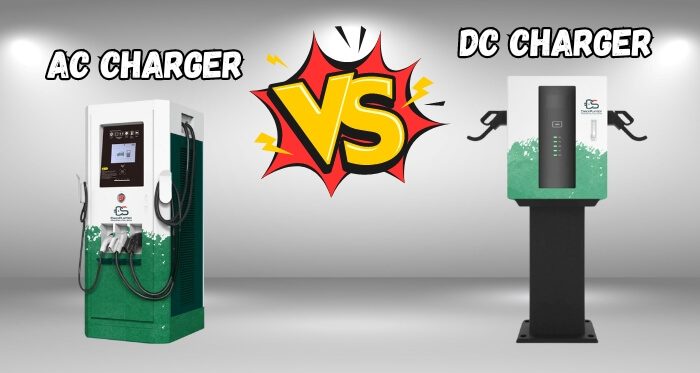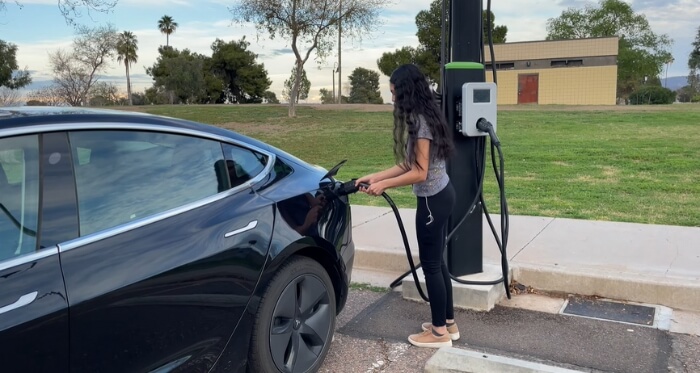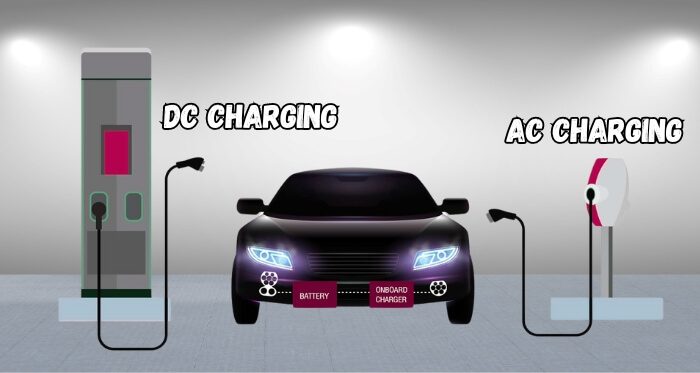Electric vehicles are rising in various parts of the world. They are engineered to convert higher energy from the grid to the wheels, making them more energy-efficient than internal combustion engine vehicles.
While plugged into a charging station the transfer begins from grid to wheel. It’s a complex process for many general users of EVs. Therefore, a fundamental query related to that is ‘Do EV chargers use AC or DC?’ hinges on their mind.
In general, the EV charging systems store energy as Direct Current (DC). But the chargers come in both AC and DC depending on the method of the charging station. Most home EV chargers operate on Alternating Current (AC), while public charging stations can offer either AC or DC charging options.
This differentiation has important implications for how we charge our electric vehicles and their efficiency. Discover how EV charging technologies affect your daily use of electric cars as we explore the ins and outs of these technologies.
A Quick Overview of the AC and DC System
EV charging technology depends on two types of electrical currents: Alternating Current (AC) and Direct Current (DC). AC is most commonly used in home charging setups, while DC is typical in faster, public charging stations. In order to fully comprehend EV charging and the systems involved, it is essential to understand these systems.
Chargers that use AC power convert the electricity into a form that is suitable for EV batteries, often at a slower rate, making them ideal for overnight charging of an EV.
A DC charger, on the other hand, bypasses this conversion and instead charges the battery directly, allowing for a faster charge time. Therefore, DC chargers are more effective for rapid charging needs as a result of this.
A Comparative Analysis for ‘Do EV chargers use AC or DC in charging system?’
EV chargers use both AC and DC charging systems so that they can be used for different types of charging. In general, electric chargers at home use AC power; however, public charging stations may offer DC power for faster charging. As a result of this dual approach, EV usage, and efficiency are taken care of in various ways.

In Bangladesh, Crackplatoon CSL has both types of charging setups for EV users in this region. As govt of Bangladesh is permitting the installation of EV charging stations. Crackplatoon EV charging is a way-to-go solution for new investors of public charging setup, and also for individual users who want to set up a private station.
Moving forward with the subject, now we will present related factors for the comparative analysis of the question ‘Do EV chargers use AC or DC in the charging system?’ As already said the charging system adapts the both AC and DC methods. Here is the analysis.
AC Charging at Home
The EV charger you use at home typically uses Alternating Current (AC) as these chargers convert AC to DC inside the vehicle, which suits the overnight charging needs. Despite being a slower charger, the AC charging units are cost-effective and easy to use, which makes the AC chargers ideal for regular, long-duration charging at home.
DC Charging in Public
Public charging stations often provide Direct Current (DC) charging units. DC chargers bypass your vehicle’s internal conversion system and supply power directly to its battery. As a result, it takes less time to charge, which is suitable for long journeys. DC charging stations are strategically placed in public areas for quick, efficient charging.
Efficiency and Speed Factors
The choice between AC and DC charging affects efficiency and speed. AC chargers, while slower, are more energy-efficient during the conversion process. DC chargers offer speed but require more complex, expensive infrastructure. Thus, the balance of speed and efficiency is crucial in charger selection.
Compatibility with EV Models
Not all EVs are compatible with all types of chargers. Most EVs can be charged with AC, but DC charging requires compatible on-board technology. The vehicle model and charger type must align for optimal charging. This compatibility is crucial for effective EV use.
Installation and Accessibility
Installation complexities differ between AC and DC chargers. Home AC chargers are simpler to install and more accessible for private use. DC chargers, however, require robust infrastructure, making them less common in residential settings.
Cost Considerations
Cost is a significant factor in choosing between AC and DC chargers. AC chargers are generally more affordable, both in terms of installation and usage. DC chargers, offering rapid charging, are costlier to install and operate, reflecting their advanced technology and quicker charging capability.
In order to make informed decisions about charging EVs, you need to understand these factors. It doesn’t matter whether you’re choosing a home charger or planning a route with public charging stations that are easily accessible; this is critical.
What’s the Difference Between AC & DC Chargers?
As you already know, there are two types of EV chargers: Alternating Current (AC) and Direct Current (DC). Each type has unique characteristics, influencing how they charge an EV. Understanding these differences is crucial for EV users to optimize their charging strategy.

AC Chargers: A Home Charging Solution
AC chargers, commonly used in homes, convert AC from the power grid to DC for the car’s battery. This conversion process occurs within the vehicle, making the charger less complex. While this method is slower, it’s more suitable for overnight charging, offering convenience for daily use.
AC chargers are also cheaper, both in installation and operation. Their simplicity and lower power requirements make them ideal for residential settings. However, the slower charging speed is a trade-off for these benefits, making them less ideal for rapid charging needs.
DC Chargers: Fast Charging on the Go
DC chargers, found in public stations, provide power directly in DC, bypassing the car’s internal conversion system. This direct approach allows for faster charging, significantly reducing waiting times. DC chargers are essential for long-distance travel, providing quick top-ups.
However, DC chargers are more complex and expensive to install and operate. Their high power output requires robust infrastructure, making them less common in residential areas. Despite the higher costs, their speed makes them a popular choice for public charging networks.
The choice between AC and DC chargers comes down to convenience, speed, and cost. AC chargers are ideal for everyday use at home, while DC chargers are best for rapid charging on long journeys. Knowing these differences ensures the efficient and effective use of EV charging technologies.
How to Find the Suitable EV Charging Stations for Your Electric Car?
The right Electric Vehicle (EV) charging station is essential for an efficient EV experience. This process can be significantly simplified by understanding your vehicle’s requirements and using the right tools. Here’s how you can use the CrackPlatoon CSL app and other resources to find suitable charging stations for your electric car.

Step 1: Learn Your EV’s Requirements
Begin by knowing your electric vehicle’s specific charging needs. Identify the connector type it supports and its maximum charging capacity. This information is crucial to finding a compatible charging station.
Step 2: Utilize the CrackPlatoon App
Leverage the CrackPlatoon app for an efficient way to locate nearby charging stations. The app not only shows the locations but also provides details about the types of chargers, their compatibility with different EV models, and real-time availability.
Step 3: Assessment for Availability
Select a charging station that is conveniently located and fits precisely into your daily commute or travel plans. The CrackPlatoon app can help in checking real-time availability to avoid long wait times at busy stations in Bangladesh.
Step 4: Consider Charging Speed and Costs
Evaluate the charging speed offered by the station. Faster chargers may be more expensive, so balance your need for speed with the charging costs. The CrackPlatoon app often includes pricing information, helping you manage your charging budget.
Step 5: Read User Reviews and Feedback
Utilize the CrackPlatoon app or online platforms to read user reviews and ratings of different charging stations. These reviews can provide insights into the reliability, quality of service, and overall user experience at various charging locations.
These are the steps for you to follow while finding a suitable EV charging station nearby you. It is crucial to find a suitable charging station for a smooth and steady experience of the EV journey.
AC or DC EV Charger- Which One Should You Choose?
When considering electric vehicle (EV) charging, the two primary options are AC (Alternating Current) and DC (Direct Current) chargers. This choice can significantly impact the charging speed, convenience, and overall experience of using an EV. Let’s dive into the specifics of each type to aid in making an informed decision.

AC Chargers: Home and Workplace Use
AC chargers are commonly found in homes and workplaces, offering convenient but slower charging. They convert AC from the power grid to DC for battery storage, typically overnight. This method suits daily commuters, providing a full charge with minimal disruption to routine.
DC Chargers: Fast Charging Stations
DC chargers are the speed demons of EV charging, often located at public stations. They supply DC electricity directly to the vehicle, bypassing internal conversion. Ideal for long journeys, they can recharge most EV batteries to 80% in under an hour.
Cost and Installation Considerations
Comparing costs, AC chargers are generally more affordable and easier to install. They require less complex infrastructure than DC chargers. However, DC chargers, while more expensive, offer the advantage of rapid charging, a crucial factor for many EV users.
So, the AC chargers are preferable for home-based use while the DC chargers are adaptable for public or outer locations-based use.
The Future Aspects of EV Chargers
As we look ahead to the future of electric vehicles (EVs), the evolution of EV chargers is a key aspect worth exploring.
Advanced Charging Technologies
Future EV chargers will likely incorporate cutting-edge technologies like bidirectional charging, allowing EVs to not only draw power but also send excess energy back to the grid. This innovation can transform EVs into mobile power sources, reshaping energy distribution.
Enhanced Efficiency and Speed
Expect faster charging times with improved battery technology and charging infrastructure. Charging stations will become more widespread, making long journeys in EVs even more convenient and accessible.
Sustainability and Green Initiatives
EV charger suppliers are increasingly focusing on sustainability. We anticipate the widespread deployment of renewable energy sources at charging stations, reducing the environmental impact of EV charging while reinforcing the role of EVs in combating climate change.
The future of EV chargers is exciting, with innovations poised to revolutionize the EV landscape, making charging more efficient, accessible, and sustainable.
Bottom Lines
The exploration of EV charging technology, particularly the question “Do EV chargers use AC or DC?”, reveals a nuanced landscape. AC chargers, ideal for home use, offer cost-effective and convenient charging, albeit at a slower pace. Conversely, DC chargers provide rapid charging at public stations, essential for longer journeys.
This dual system ensures flexibility and efficiency, catering to diverse needs. As the EV market evolves, future advancements in charging technologies promise even greater efficiency and sustainability.
This continuous innovation underscores the importance of understanding the distinct roles of AC and DC chargers in the realm of electric vehicles, ensuring users can make informed choices for their specific needs.
